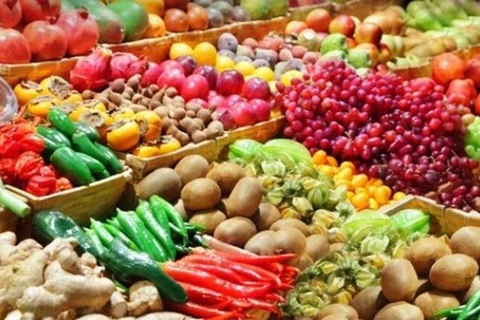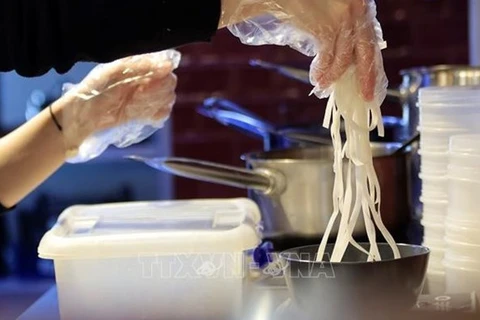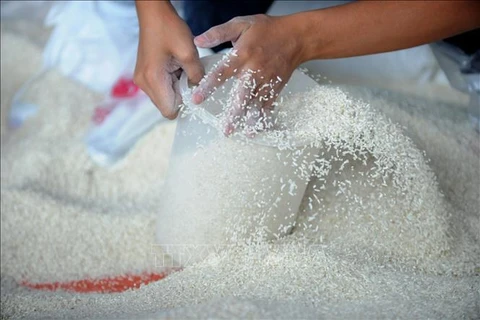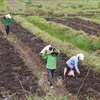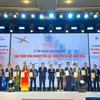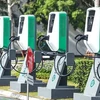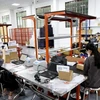 Pineapples are being processed for export at a Dong Giao Foodstuff Export JSC factory in Gia Lai province.(Photo: VNA)
Pineapples are being processed for export at a Dong Giao Foodstuff Export JSC factory in Gia Lai province.(Photo: VNA) In 2025, the processed products would account for 30% of Vietnam's total agricultural, forestry and fishery products exported to the EU. About 20% of the exported agricultural, forestry and fishery products to the EU would be sold directly at retail channels in this market.
Those percentages would increase to 50% and 30%, respectively, by 2030, according to a scheme developed by the Ministry of Agriculture and Rural Development (MARD). The export value of such products to the EU market is also targeted to increase to 7.5-8 billion USD by 2030.
The ministry has put in place many solutions to achieve these goals, such as increasing the connection and participation among ministries, sectors and localities.
It will focus on changing farmers' awareness and habits in the production of farming products. In addition, it is also necessary to improve the infrastructure for agricultural production as well as aquaculture and processing of seafood to meet EU standards.
It is also necessary to implement economic reforms, especially matters relating to agriculture and land, and policies and institutions on science, technology and State management. Those will help Vietnam improve the competitiveness of farm produce and achieve sustainable agricultural development in the long term.
The export of Vietnamese agricultural products is facing many big challenges, including internal limitations in the development process of the sector and increasingly strict commitments on product quality and environmental standards.
Vietnam's agricultural exports have great opportunities in expanding markets, improving the value and quality of export products, attracting investment and modern production technology from joining the EU-Vietnam Free Trade Agreement to boost exports to this market.
Currently, the EU is one of the four major export markets for Vietnam's agricultural, forestry and fishery products. The EU is also one of the world's three largest markets for agricultural, forestry and fishery products.
Vietnam is one of four Asian countries to sign an FTA with the EU. Therefore, to effectively exploit the advantages of the EVFTA, Vietnamese agricultural products must improve their quality and value.
According to Nguyen Kien, head of MARD's Department of International Cooperation, the EU annually spends about $1 trillion on food and beverages, including $300 billion on imports.
The Loc Troi Group Joint Stock Company said that about 500 tonnes of branded "Vietnamese Rice" delivered by the company in June would arrive in Germany, the Netherlands and France in July. Of which, "Vietnamese Rice" exported to France will be sold at Carrefour, a large supermarket system.
This is the first step in the group's journey of bringing Loc Troii's rice to the world market.
In February 2022, the Golden Gate Joint Stock Company cooperated with Western Farm Co, Ltd. to export the first batch of mangoes to the EU market.
This batch of mangoes supplied by the Tinh Thoi Agricultural Service Cooperative in Dong Thap province has an export price of 11-13 euros per kilo. The price of this fruit at supermarkets in the EU is 18 euros per kilo.
However, according to Kien, some Vietnamese agricultural products still have low export volumes to the EU. In addition, Vietnam's agricultural exports to this market are facing great competitive pressure.
Specifically, Vietnamese vegetables and fruits have major competitors from South America, West Africa, South Africa, Thailand, the Philippines, India and China.
Meanwhile, coffee, pepper and cashew products of Vietnam must compete with products of Indonesia, India, Brazil, Ivory Coast and Mozambique.
Its seafood products face competition from products of Norway, China, Ecuador and Morocco.
Kien said to increase exports to the EU, Vietnam's large enterprises need to promote the building of a supply chain for exports to reduce transportation costs and develop their brands.
According to Nguyen Thi Thuong Linh, deputy director of the Vietnam Chamber of Commerce and Industry (VCCI)'s branch in Can Tho, to take advantage of the EVFTA in exporting farm produce to the EU, the enterprises and farmers must cooperate in building supply chains for exports.
Nguyen Dinh Tung, general director of the Vina T&T Company, said the difficulty for the export of agricultural products, especially fruits, today is preservation. The most important factor is researching preservation technology to keep agricultural products fresher for longer.
Besides that, the enterprises need support from State management offices and associations in carrying out advertising and marketing activities.
Dr Nguyen Dac Binh Minh, director of the Institute of Regional Research and Development under the Ministry of Science and Technology, has also noted the traceability of export products because this is a mandatory requirement of many multilateral FTAs, especially that with the EU./.
VNA
